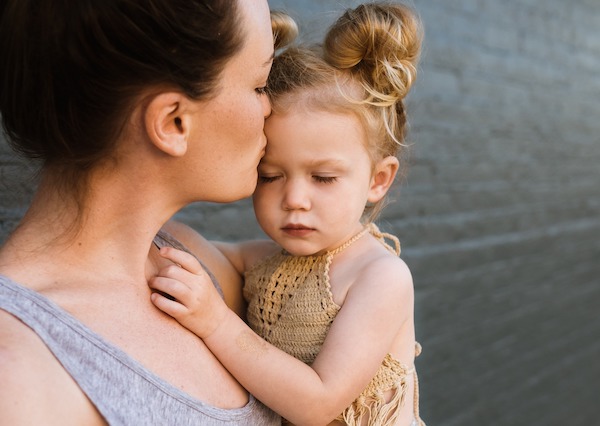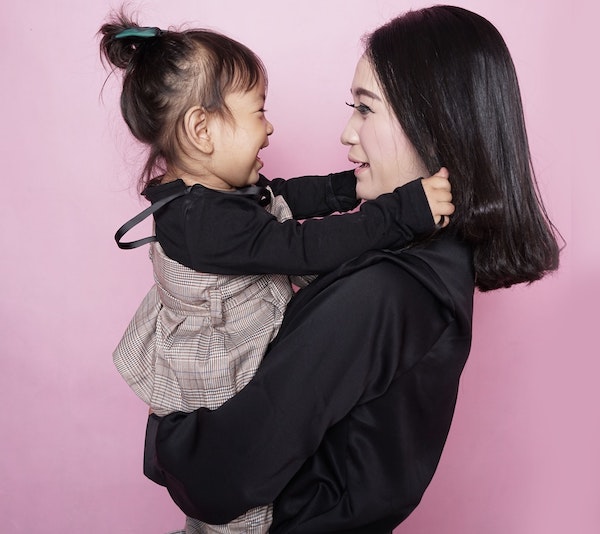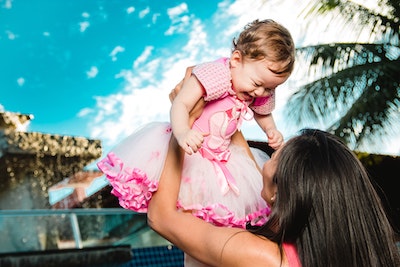Bonding is the foundation of many relationships. You can see bonds between family, friends, pets and their owners. But perhaps the strongest bond of all is between mothers with their children. These bonds are a set of feelings that include attachment and reward for attachment. In many scientific fields, bonding is the basis of love. But what creates a bond? What is the chemical interaction behind the formation of that bond?
For a mother, the bond with an infant is indescribable. It involves recognizing the baby as yours. It compels the innate desire to provide food, comfort, warmth, and protection. This is often described as a mother’s intuition. But, did you know there is actually a lot of scientific research behind mommy-baby bonding?

Mommy-Baby Bond
For many years, researchers have been exploring the connection between the neuroendocrine hormone and monoamine. These are just long, scientific names for oxytocin and dopamine. Together, these two chemicals are critical in the formation of mother-child bonds.
In fact, the release of dopamine and oxytocin in the brain initiates and maintains these bonds. Certain actions produce both oxytocin and dopamine. This can be as simple as holding a baby or eye contact during playtime.
Of course, there is a lot more science behind it than just that. Curious to learn more? Keep reading to learn about the connection between dopamine, oxytocin, and mother-child bonding.
| Find more articles about parenting, pregnancy and products for newborns and toddlers on LittleBabyGear.com! |
What Is Oxytocin?
Oxytocin is one of the many hormones our bodies produce. Women, men, and children alike produce this hormone.
The research around this hormone originally started with the connection surrounding lactation and birth. Recent research has looked at the influence oxytocin has on relationships and human behavior. Most of the research has looked at animals and their maternal behavior and caregiving. With the connections studied there, research has expanded to include humans, specifically mothers and children.
Oxytocin is the center point for trust, intimacy, and healthy relationships. During childbirth and breastfeeding, a mother will release tons of oxytocin. Mothers experience significant connection with their baby during both these activities.
Given the closeness of the interaction, this is understandable. It is essential for forming bonds and improving interactions between pairs of people. Sometimes, it is even referred to as “the cuddle hormone”. Why? Because in fact, hugging someone helps oxytocin flow. Research suggests 8 hugs a day as an ideal number for oxytocin production.

What Is Dopamine?
Dopamine is a neurotransmitter in the brain. It is a chemical that acts as a messenger between neurons. This neurotransmitter specifically helps with:
- Attention
- Movement regulations
- Emotional responses
- Learning
Dopamine allows for award recognition and spurs the desire to take action toward rewards. It is responsible for inspiring satisfaction and pleasure from certain actions. It is a huge part of the brain’s reward system. For a baby, that reward is often the mother’s attention.
When it comes to mother-baby bonds, dopamine is a huge part of the attachment. It plays a role in the rewards that come with motherhood and baby needs. On some level, babies recognize their mother as a form of attachment and reward. Dopamine also spurs the emotional connections between mother and child.
What Is the Relationship between Oxytocin and Dopamine?
With their two singular functions, it is easy to see how they combine to help with the creation of bonds. The main difference that plays a role in their function is what spurs the release. For oxytocin, its release depends on oxytocin actions. Remember, it’s the cuddle hormone! The brain releases dopamine from the hypothalamus and transmits it throughout the rest of the brain.
The two begin to interact based on receptor patterns spurred by the oxytocin action. Dopamine depends on the release of oxytocin. The two spur the feelings of maternal connection that a mother experiences with a child.
Oxytocin stimulates dopamine. In turn, it creates reward and motivation for attachment. Basically, dopamine and oxytocin form a reciprocal relationship. This relationship lies beneath love and bonding.
How Does Oxytocin Influence Mommy-Baby Bonding?
Oxytocin and dopamine influence mommy-baby bonding from childbirth. The action of holding a newborn is one of those actions that spur oxytocin. This combines with dopamine to target various areas of the brain. This spurs maternal behaviors.
Research has found a link between dopamine neurons and oxytocin projections. This link has shown a connection between oxytocin, dopamine, and maternal instincts. Of course, scientists conducted the study on rats. At present, further research is exploring the same connection in humans.

Further studies have expanded to include prairie voles as well. Those studies explore the connections between parental behaviors and even partner preferences. The research tracks the oxytocin release during pairing and the subsequent bonds. Various actions stimulate the oxytocin release. This extends to actions that mothers and children engage in. Some actions include holding the baby, nursing, and more.
Maternal Behavior, Oxytocin, and Dopamine
Not all of the research revolves around rats and prairie voles though! Some human studies have established factors that increase oxytocin. These factors include touch, gaze, and positive interactions. This creates a bond between infants and mothers. For adult relationships, oxytocin increases trust. This translates over to mother-infant bonds as well.
Oxytocin and subsequently, dopamine, creates mutual synchrony and rewards. When mothers and babies share oxytocin-based on interactions, the synchrony increases. Basically, more gazes, physical touch, and positive interactions increase oxytocin and dopamine. This results in a stronger bond.
For mothers specifically, certain maternal behavior results in oxytocin release for mothers. This oxytocin spurs even more maternal behaviors. Researchers often referred to this as a “bio-behavioral feedback loop.” The loop becomes stronger with more oxytocin-generating actions. Combined, these create an attachment between mother-infant.
Child Attachment, Oxytocin, and Dopamine
The relationship goes two ways! Babies also feel the effects of the release of dopamine and oxytocin. As a mother responds to a baby, babies also respond to mothers. Think of tickling a baby and the giggling as a result. Often, the baby holds the mother’s gaze and reaches for more or wiggles around. This is oxytocin and dopamine in action for the baby.
Mothers and babies have a delicate but strong bond. Each responds and influences one another. The result is a development of attachment and feeling of security between the two.
What Happens without Oxytocin and Dopamine?
As you can imagine, dopamine and oxytocin are important in the creation of mommy-baby bonds. So, what happens without it? Basically, there will be limits on certain maternal actions without oxytocin. Dopamine production will be limited as well. Oxytocin actually plays a role in the production of breastmilk by promoting the movement of milk. Without oxytocin, breastfeeding might be impacted.
In addition, low levels of oxytocin lead to low empathy. Given the part of the brain that produces the hormone, oxytocin influences many bodily functions. Impacted areas can include appetite, sleep, thirst, libido, and mood. For mothers, this can be impactful in the relationship with a baby.
What Might Inhibit Oxytocin or Dopamine?
One of the main factors that inhibit oxytocin and dopamine are symptoms of depression. For women, this can be likely due to the prevalence of Post-Partum Depression. This is common after childbirth but can escalate into a debilitating depression.
Post-Partum Depression is characterized by insomnia, mood swings, anxiety, and crying spells. The feelings formed by Post-Partum Depression can interfere with the formation of bonds between mother and baby. This is because with depression, there are low levels of oxytocin. All of these factors closely intertwine. Therefore, they play critical functions in motherhood.
Infant Attachment and Maternal Behaviors
Maternal behaviors are far-reaching and encompass a number of actions. Two of the most important ones involve exploration and welcoming. This encompasses the baby’s exploration and the mother’s ability to allow that exploration. As well, the mother welcomes the baby back in times of need.
Some studies suggest oxytocin helps with maternal behavior by developing infant attachment. On one level, attachment takes shape through actions like physical touch. On another level, it also forms when the mother allows the baby to explore and return by their own will.
For example, remember that tickling example? At some point, the baby might look away or show interest in a nearby toy. This is an indicator of shifting interest and exploration. In this scenario, the mother allows the baby to divert but still welcomes the baby back. This is when the baby begins to associate the mother with security.
Basically, the baby comes back in times of need, like when hunger strikes. Even these small moments of letting go still create bonds between mommy and baby.
Mother-Infant Communication through Eye Gaze
One important oxytocin-producing action is eye contact. Gazing into another person’s eyes is a function of communication. It is a key component of maternal sensitivity as well as infant attachment.
Emotional regulation for infants actually stems from gaze aversion. Does your baby look away in moments of play? It could be that they are actually over-excited and regulating their emotions. As mentioned before, looking away is also a way of exploring for the infant.
For the mom, gaze aversion might feel like rejection. However, for the baby, it can just be boredom, fatigue, or diverted interest. One of the areas of oxytocin study is how that hormone influences a mother’s welcoming. How does she respond when the baby “comes back” after breaking that eye contact? The research here is still growing. The idea is that higher levels of oxytocin lead to a more welcoming environment after gaze aversion.

More About the Research
Many of the articles on this topic are chock full of scientific terms. However, they can be broken down into digestible ideas. To understand the science behind it all, let’s briefly summarize two articles. We’ll go over how they tie into the relationship between oxytocin, dopamine, and mommy-baby bonding.
“Baby Love? Oxytocin-Dopamine Interactions in Mother-Infant Bonding” by Alison J. Douglas
This 2010 article from Alison Douglas dives into dopamine, oxytocin, and research around mother-infant bond in rats. The question stemmed from the ill-defined relationship of where and how oxytocin develops in maternal behavior.
The study specifically uses a model from the Meaney lab. It defines “good” mothers among rats as those who exhibit certain behaviors. Those behaviors include grooming, licking, and nursing. It maps where in the brain that oxytocin goes. It also looks at “poor” mothers. The findings discovered different receptor patterns between “poor” and “good” mothers.
“Oxytocin, motherhood and bonding” by Keith M. Kendrick
A study from 1991 gives insight into how oxytocin influences social, sexual, and maternal bonding. It explores several animal species, including rats and lambs. It explores oxytocin and various receptors in the brain.
One of the findings revolves around what influences oxytocin levels. The research shows sheep bearing the first lamb can have more difficulty with post-partum maternal connections. This is in comparison to a sheep with multiple lambs.
For humans, it would mean a first-time mom might struggle more with baby bonding versus a mom of multiple babies. An interesting finding in the study is that damage to the source of oxytocin production can delay maternal instincts.
Conclusion
Overall, oxytocin and dopamine are important when forming relationships between mother and baby. They factor, as well, into a number of other types of relationships. Maternal actions create higher levels of oxytocin. In turn, this creates more dopamine. All of this generates feelings of connection, trust, and bonding. Low levels of oxytocin can threaten these connections, which can result from Post-Partum Depression.
These hormones and neurotransmitters can also affect security and attachment between mother and baby. Exploration, gaze, and other factors influence attachment. By allowing babies to disengage and return in times of need, mothers stimulate security connections with their babies. The research is ever-growing with clear directions for the future.
Future Questions
While the research is growing, many questions remain. Most of those questions revolve around replicating the studies on larger scales. Individual responses can always affect the outcomes of the studies. As such, further studies will require more subjects. Other areas of research also include further differentiating between maternal behavior and infant behavior. How exactly does one influence the other? There are solid foundations to promote connections between motherhood, dopamine, and oxytocin.
Bibliography:
Please keep in mind that this article IS NOT a medical advice. The purpose of this article is informative and it should NOT be used as a substitute for consultation with a doctor. Always consult your health concerns and decisions with your doctor.

